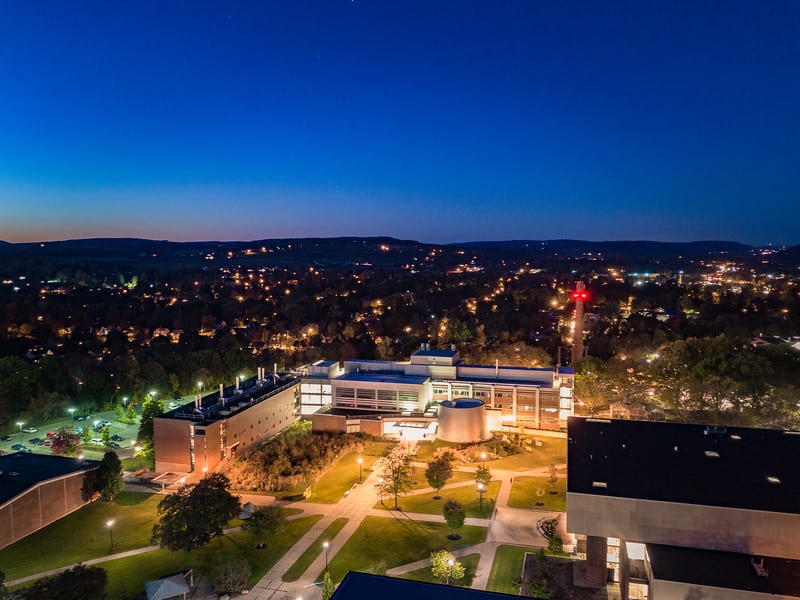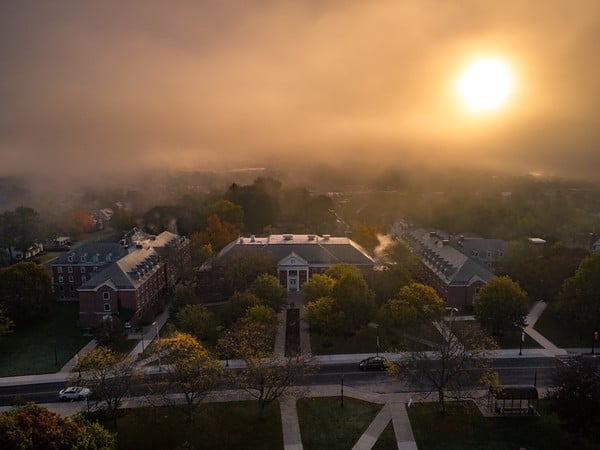How to Get Hired for, Price, and Execute a Large Scale Aerial Project: An Interview with Professional Photographer and Videographer Clifford Pickett
BY Zacc Dukowitz
22 February 2023We met Drone Pilot Ground School alum Clifford Pickett recently when he sent us some shots of a big aerial project he did for the State University of New York (SUNY).
Check out these shots from the project:

Photo credit: Clifford Pickett

Photo credit: Clifford Pickett

Photo credit: Clifford Pickett
We were impressed by the scope of the project and the quality of Clifford’s work, so we wanted to talk to him to learn more about how he got the job, how he priced it, and how he went about planning and executing such a big project.
—
Begin interview:
How did you get the SUNY job?
Persistence, is the short answer.
The back story is, a while back I came across this beautiful castle in Westchester, New York just a few miles down the road from where I live.
I looked it up online, and I didn’t see too many aerial photographs of it, so I tried reaching out to them but wasn’t able to get ahold of anyone.
So I photographed the castle during a couple of sunrises, and sent them an email with some of the images, saying I’d like to work with them.
They replied right away, and they loved the images. And since then they’ve been a long-term client.
Fast forward a few years, and SUNY was going to hold a conference at that castle and someone from SUNY contacted me to see if they could use my images of the castle to promote the conference. So that was my first introduction at SUNY.
Some time later they were planning a large reunion at SUNY, and they wanted to do a big celebration. There was a lot of new architecture, and they’d done a lot of cleaning and really made the campus look great, and they wanted to document things as they were.
And that’s how I ended up getting hired to do this project.

Photo credit: Clifford Pickett
Tell us about executing this project. How did you plan for it?
Big picture, I wanted to make sure I had extra time in case things went wrong.
When you work with aerial, the landscape is critical. And with the SUNY project being tied to the timing of the fall foliage, I knew that we were looking at a little bit of a lottery—between travel and weather, possible fog, which we did have, and how long the leaves stay on the trees, there’s always a chance you might miss your window.
In a controlled environment, when you’re working in a studio and you’re bringing in your lighting, that’s different.
But when you’re working outside, it’s important to have a little bit of leeway and give yourself longer than you think you actually need for the shoot.
So I made sure to have extra time built into my schedule, just in case. I went up a few days early, and built that time into the proposed budget.
In the end, I was able to deliver more than they had initially expected, even though the first day on shoot was overcast, foggy, and raining.

Photo credit: Clifford Pickett
How did you approach pricing for this project?
My approach to pricing can vary depending on the specifics of the project, but in general I like to price everything up front as a single package: the cost of transportation, lodging, my time on the day of shooting, and the images themselves.
This means that the upfront number I present might seem high, especially if someone has never hired a professional photographer before. But it also means that I’m being completely transparent about pricing, and there won’t be any hidden costs that will pop up later.
And this is what I emphasize when going over the packaging price. I also like taking this approach when working with a large institution like SUNY, where payment is usually subject to bureaucratic procedures, and it’s easier to just get permission to pay once for a pre-approved amount.
The real value here is that, once that price is agreed to, I’m promising to take care of everything else. They don’t need to find me lodging or transportation, or worry about a per diem or separate reimbursements. It’s all included.
Is that how you usually price things?
I do typically approach pricing like this, in lump sum, because I think it’s just a lot more practical.
I don’t like how some people throw in add-ons to a project, and essentially present a client with one number up front, knowing that the project could cost a lot more by the time it’s done.
I’d rather just work with clients so that they can understand the value up front, and give them the price for the full package without anything hidden in the pricing.
Of course, pricing does vary by location. In New York City, for example, work will cost more than in other locations in the U.S.

Photo credit: Clifford Pickett
[Want some more info on how to price your aerial services? Check out this thread on our community forum.]
Talk us through your sales process. How do you find new clients, and how do you close deals with them?
I like to reach out to the decision maker in an organization and try to set up a meeting. If I can get an introduction that’s great, but it’s not necessary.
I always make sure to research the potential client before that first meeting, whether it’s a hotel, a commercial property, or a university.
I look at what they already have in terms of photography, and what it looks like they need. This really helps you get a feel for the scale of the work they might want, and a rough sense for what their budget might be.
Obviously, it’s going to be a different package for a small seaside motel, than for a large resort in a popular tourist city.
I also make sure not to talk about pricing until I meet with the potential customer. Meeting face to face has an x factor that is really important. I’ve always found that’s it’s important to meet in person before you talk numbers.
Usually I’ll take a few shot ahead of time, or I’ll put together a private page that I can send to the decision maker. I’ll explain to them this is the work I’ve done, and if I have the time I will do some shoots of sunrises or sunsets a day or two before. I’ll also explain what I’d like to do for the project, and this gives them something in their hands, and it gets me a foot in the door to have a conversation.
After we’ve talked and I get a better sense for what they want, that’s when we can figure out pricing. But I don’t go into a meeting with a set price in mind—it really does depend on the scale of the work, the scope of the project, and that conversation with that decision maker.
All of this is so much better, and more successful for both the customer and me, than just a cold email saying, “Hey, here’s my price structure, and you can take it take it or leave it.”
What drones do you fly, and what cameras do you use?
I fly a Phantom 4 Pro and a Mavic Pro. I work with the cameras that come with those two models, and with several other cameras as well.


